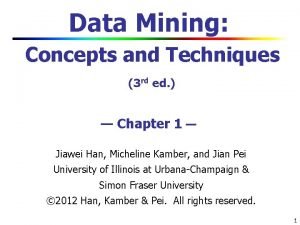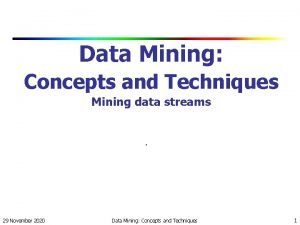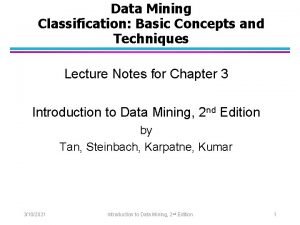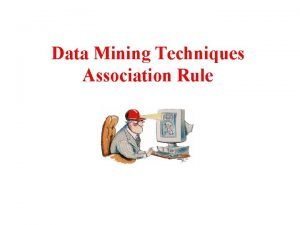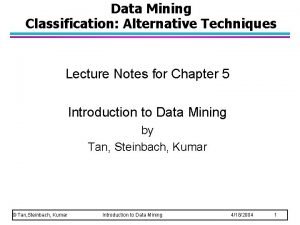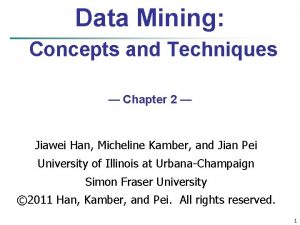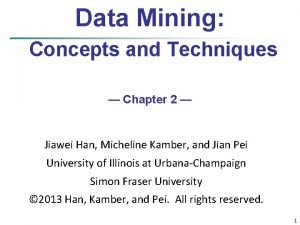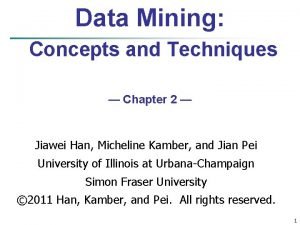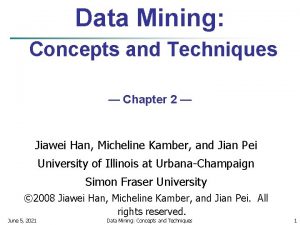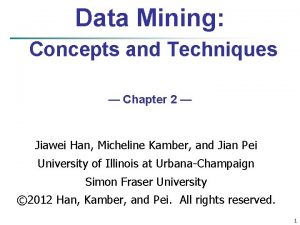Data Mining Concepts and Techniques Chapter 2 Jiawei





















- Slides: 21

Data Mining: Concepts and Techniques — Chapter 2 — Jiawei Han, Micheline Kamber, and Jian Pei University of Illinois at Urbana-Champaign Simon Fraser University © 2011 Han, Kamber, and Pei. All rights reserved. 1

Chapter 2: Getting to Know Your Data n Data Objects and Attribute Types n Basic Statistical Descriptions of Data n Data Visualization n Measuring Data Similarity and Dissimilarity n Summary 2

Types of Data Sets n n Record n Relational records n Data matrix, e. g. , numerical matrix, crosstabs n Document data: text documents: termfrequency vector n Transaction data Graph and network n World Wide Web n Social or information networks n Molecular Structures Ordered n Video data: sequence of images n Temporal data: time-series n Sequential Data: transaction sequences n Genetic sequence data Spatial, image and multimedia: n Spatial data: maps n Image data: n Video data: 3

Important Characteristics of Structured Data n Dimensionality n n Sparsity n n Only presence counts Resolution n n Curse of dimensionality Patterns depend on the scale Distribution n Centrality and dispersion 4

Attributes n Attribute (or dimensions, features, variables): a data field, representing a characteristic or feature of a data object. n n E. g. , customer _ID, name, address Types: n Nominal n Binary n Numeric: quantitative n Interval-scaled n Ratio-scaled 6

Attribute Types n n n Nominal: categories, states, or “names of things” n Hair_color = {auburn, black, blond, brown, grey, red, white} n marital status, occupation, ID numbers, zip codes Binary n Nominal attribute with only 2 states (0 and 1) n Symmetric binary: both outcomes equally important n e. g. , gender n Asymmetric binary: outcomes not equally important. n e. g. , medical test (positive vs. negative) n Convention: assign 1 to most important outcome (e. g. , HIV positive) Ordinal n Values have a meaningful order (ranking) but magnitude between successive values is not known. n Size = {small, medium, large}, grades, army rankings 7

Numeric Attribute Types n n n Quantity (integer or real-valued) Interval n Measured on a scale of equal-sized units n Values have order n E. g. , temperature in C˚or F˚, calendar dates n No true zero-point Ratio n Inherent zero-point n We can speak of values as being an order of magnitude larger than the unit of measurement (10 K˚ is twice as high as 5 K˚). n e. g. , temperature in Kelvin, length, counts, monetary quantities 8

Discrete vs. Continuous Attributes n n Discrete Attribute n Has only a finite or countably infinite set of values n E. g. , zip codes, profession, or the set of words in a collection of documents n Sometimes, represented as integer variables n Note: Binary attributes are a special case of discrete attributes Continuous Attribute n Has real numbers as attribute values n E. g. , temperature, height, or weight n Practically, real values can only be measured and represented using a finite number of digits n Continuous attributes are typically represented as floating-point variables 9

Chapter 2: Getting to Know Your Data n Data Objects and Attribute Types n Basic Statistical Descriptions of Data n Data Visualization n Measuring Data Similarity and Dissimilarity n Summary 10

Basic Statistical Descriptions of Data Motivation n To better understand the data: central tendency, variation and spread n Data dispersion characteristics n median, max, min, quantiles, outliers, variance, etc. n Numerical dimensions correspond to sorted intervals n Data dispersion: analyzed with multiple granularities of precision n Boxplot or quantile analysis on sorted intervals n Dispersion analysis on computed measures n Folding measures into numerical dimensions n Boxplot or quantile analysis on the transformed cube n 11

Measuring the Central Tendency n Mean (algebraic measure) (sample vs. population): Note: n is sample size and N is population size. n n Weighted arithmetic mean: n Trimmed mean: chopping extreme values Median: n Middle value if odd number of values, or average of the middle two values otherwise n n Estimated by interpolation (for grouped data): Mode n Value that occurs most frequently in the data n Unimodal, bimodal, trimodal n Empirical formula: 12

Symmetric vs. Skewed Data n Median, mean and mode of symmetric, positively and negatively skewed data positively skewed 05 June 2021 symmetric negatively skewed Data Mining: Concepts and Techniques 13

Measuring the Dispersion of Data n Quartiles, outliers and boxplots n Quartiles: Q 1 (25 th percentile), Q 3 (75 th percentile) n Inter-quartile range: IQR = Q 3 – Q 1 n Five number summary: min, Q 1, median, Q 3, max n Boxplot: ends of the box are the quartiles; median is marked; add whiskers, and plot outliers individually n n Outlier: usually, a value higher/lower than 1. 5 x IQR Variance and standard deviation (sample: s, population: σ) n Variance: (algebraic, scalable computation) n Standard deviation s (or σ) is the square root of variance s 2 (or σ2) 14

Boxplot Analysis n Five-number summary of a distribution n n Minimum, Q 1, Median, Q 3, Maximum Boxplot n n n Data is represented with a box The ends of the box are at the first and third quartiles, i. e. , the height of the box is IQR The median is marked by a line within the box Whiskers: two lines outside the box extended to Minimum and Maximum Outliers: points beyond a specified outlier threshold, plotted individually 15

Graphic Displays of Basic Statistical Descriptions n Boxplot: graphic display of five-number summary n Histogram: x-axis are values, y-axis repres. frequencies n Quantile plot: each value xi is paired with fi indicating that approximately 100 fi % of data are xi n Quantile-quantile (q-q) plot: graphs the quantiles of one univariant distribution against the corresponding quantiles of another n Scatter plot: each pair of values is a pair of coordinates and plotted as points in the plane 18

Histogram Analysis n n Histogram: Graph display of tabulated frequencies, shown as bars It shows what proportion of cases fall into each of several categories Differs from a bar chart in that it is the area of the bar that denotes the value, not the height as in bar charts, a crucial distinction when the categories are not of uniform width The categories are usually specified as non-overlapping intervals of some variable. The categories (bars) must be adjacent 19

Histograms Often Tell More than Boxplots n The two histograms shown in the left may have the same boxplot representation n n The same values for: min, Q 1, median, Q 3, max But they have rather different data distributions 20

Quantile Plot n n Displays all of the data (allowing the user to assess both the overall behavior and unusual occurrences) Plots quantile information n For a data xi data sorted in increasing order, fi indicates that approximately 100 fi% of the data are below or equal to the value xi Data Mining: Concepts and Techniques 21

Scatter plot n n Provides a first look at bivariate data to see clusters of points, outliers, etc Each pair of values is treated as a pair of coordinates and plotted as points in the plane 23

Positively and Negatively Correlated Data n The left half fragment is positively correlated n The right half is negative correlated 24

Uncorrelated Data 25
 Data mining confluence of multiple disciplines
Data mining confluence of multiple disciplines Function of data mining
Function of data mining Data mining slides
Data mining slides Data mining concepts and techniques slides
Data mining concepts and techniques slides Team jiawei
Team jiawei Mining complex types of data
Mining complex types of data Multimedia data mining
Multimedia data mining Basic concepts in mining data streams
Basic concepts in mining data streams Basic concepts of classification in data mining
Basic concepts of classification in data mining Binning methods in data mining
Binning methods in data mining Association data mining techniques
Association data mining techniques Classification alternative techniques in data mining
Classification alternative techniques in data mining Difference between strip mining and open pit mining
Difference between strip mining and open pit mining Text and web mining
Text and web mining What is data mining and data warehousing
What is data mining and data warehousing Olap data mart
Olap data mart Data warehousing data mining and olap
Data warehousing data mining and olap Introduction to data mining and data warehousing
Introduction to data mining and data warehousing Strip mining vs open pit mining
Strip mining vs open pit mining Strip mining vs open pit mining
Strip mining vs open pit mining Data reduction in data mining
Data reduction in data mining What is missing data in data mining
What is missing data in data mining

